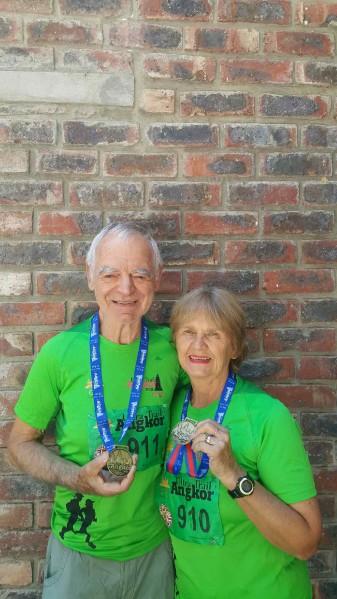We had always wanted to visit Siem Reap in Cambodia, with its amazing temples like Angkor Wat and Angkor Bayon, so when we came across the Angkor Ultra Trail website by chance, we just had to adjust our trip to fit in with the race. – BY LIONEL & MARIE HILL
Scrolling through information regarding a vacation in Cambodia, our eyes fell on an item about the Angkor Ultra Trail, to be run for the third time in January. We had never done an international race on our previous travels, but here was an opportunity to combine travel with participation in a unique race right near the Angkor World Heritage Site that we wanted to visit. The friendly website made the entry process easy – the only stipulation was that entries must be accompanied by a medical clearance – and everything was put in motion to make this a reality.
The site said, “Runners will cross several exceptional sites dominated by mountains and temples, evolving through impressive landscapes over a vast area, where rice fields, forests and villages offer panoramas of surprising diversity,” and offered five distances, the Ultra Trail Angkor 128km, Bayon Trail Angkor 64km, Marathon Trail Angkor 42km, Jungle Trail Angkor 32km and Temple Run Angkor 16km.” With our age and fitness level in mind – I’m 76, Marie is 72 – and even though we still run races up to 21km most weekends, we still wanted to be capable of enjoying the holiday, so we opted for the 16km race.
Historical Site
Angkor Wat, or Capital Temple, is the largest religious monument in the world. It was originally constructed by the Khmer Empire in the early 12th century as a Hindu temple, but by the end of that century had transformed into a Buddhist temple. Since then it has become a symbol of Cambodia, appearing on the national flag, and is the country's prime tourist attraction. Today it forms part of the Angkor UNESCO World Heritage Site along with Angkor Thom, the inner royal city, and a number of other temples, including Angkor Bayon.
We arrived in Siem Reap a week before the race, allowing us plenty of time for sightseeing and getting acclimatised. We did a lot of travelling, walking and climbing to see all the temples, then took a day off to rest and prepare for the race. Registration was in the Angkor Paradise Hotel, and it was no problem organising a tuk-tuk to this venue. Finally, race day arrived, and once again we took a tuk-tuk in the dark to the start point at Elephant Terrace, in front of the ruins of the Royal Palace. The venue was a hive of activity, with various briefings for just over 700 athletes from 40 countries doing the various distances, and soon we were on the bus to the 16km start.
Although the humidity was high, forcing us to walk much of the way, it was bearable, and the terrain was mainly shaded footpaths through the dense forests, past majestic temples, as well as dirt roads through rural villages. However, at one stage we had to cross a river, with water about knee-high. (Guess who had to carry who?) The refreshment tables were stocked with drinks, chocolates and fruit, so no chance of getting hungry here, and very interesting was seeing the Tourism Police as marshals on the route.
While running amongst so many nationalities made it hard to communicate at times, we runners are a friendly lot, so we managed, especially when the fitter, younger athletes participating in the longer events wanted to pass us. Marie and I took our time, stopping to take countless photos, but finally after just over three hours, we ran past Angkor Wat and arrived back at the Elephant Terrace to enjoy the aftermath of the race and the company of our fellow athletes. All participants also received a Participation Pass which allows one to stroll through the Conservation Area and temples on the day. What an experience!
You’ll find more info on the race at www.ultratrail-angkor.com
IMAGES: www.photos.sdpo.com & courtesy www.gde-fon.com


